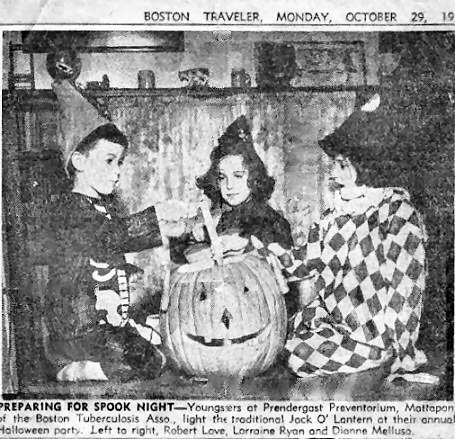
Dorchester Illustration no. 2495 Prendergast Preventorium
Illustration: Photograph from Boston Traveler, October 29, 1952. Robert Love is at the left with Lorraine Ryan and Dianne Melluso.
After hearing the Youth Poet Laureate, Amanda Gorman, present at the Inauguration, a phrase from her poem keeps coming back into mind: “It’s because being American is more than a pride we inherit, it’s the past we step into …” That places us in the position of being honest about our shared history, not just telling the good.
Although today’s illustration may provide a warm feeling about how youngsters at the Prendergast Preventorium were entertained, a very different impression emerges in the pages of a book written by a former resident. Robert A. Love’s book Promises to Keep: Memoirs of a Polished Street Fighter (copyright 2013) describes his experiences at the Preventorium as one chapter in a childhood full of difficulties, including learning to live with Tourette syndrome and continually moving from place to place, either to find an affordable apartment or being placed in institutions and foster homes.
In 1952, his mother was diagnosed with Tuberculosis and told that she needed to enter the Boston Sanatorium on River Street for treatment. Bobby and his three siblings were given a clean bill of health, but they were taken by state officials to the Prendergast Preventorium, also in Mattapan. They included Dianne, 12; Geri, 11; Eddie 8 and Bobby, 7. The Preventorium was an institution for children who were related to or exposed to people with Tuberculosis.
Love states that the Preventorium housed about 80 children. The dining room was at the center of the facility with twelve wooden picnic tables arranged in two rows. There were separate dormitories for boys and girls, on the north and south sides of the building. He describes the staff as negligent, with no training in psychology or other appropriate field. He singles out one staff member who “firmly believed that inflicting physical pain and humiliation were the best forms of discipline.” He describes the staff member pulling the hair of the children and smacking them. Other staff members were described as being adept at smacking, slapping and calling names. Many of the children developed symptoms of abuse including twitching and coughing.
The author admits there were more pleasant occasions like Halloween, but even in the photo session, where only the cutest children were chosen to pose, their minder stood close by with a “smile or I’ll beat the hell out of you attitude.”
This cautionary tale is meant to remind us that when we tell history, we need to present the truth. But what is the truth? Is it the version from Bobby’s memories?
